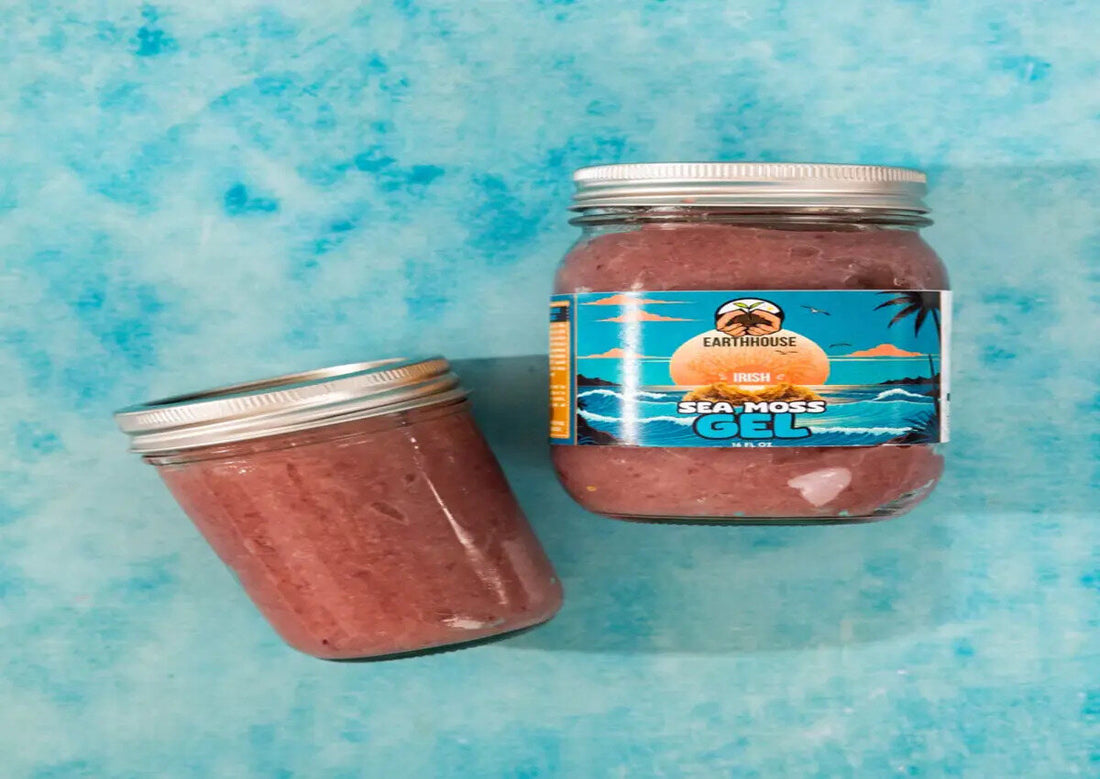Sea moss has surged in popularity as a superfood, thanks to its rich nutritional profile and potential health benefits. As more people integrate this versatile gel into their diets and skincare routines, a common question arises: how long does sea moss gel last? Whether you're a seasoned user or a newcomer, understanding the shelf life of sea moss gel and how to store it properly is crucial to maximizing its benefits.

What is Sea Moss Gel?
Sea moss, also known as Irish moss, is a type of red algae packed with over 90 essential minerals, including iodine, calcium, potassium, and magnesium. When blended with water, it transforms into a gel-like consistency, making it easy to incorporate into various recipes and beauty products. This gel form is particularly prized for its ability to enhance the nutritional value of foods and support skin health.
The Shelf Life of Sea Moss Gel
Refrigerated Sea Moss Gel
When stored in the refrigerator, sea moss gel can last between 2 to 4 weeks. The cool environment of the fridge helps to slow down bacterial growth, keeping the gel fresh. For best results, keep the gel in an airtight container placed in the coldest part of the fridge, typically the back.
Frozen Sea Moss Gel
Freezing sea moss gel is an excellent option if you’ve made a large batch. When stored properly in an airtight container, it can last up to 6 months. To avoid degrading its quality, freeze the gel in small portions using ice cube trays.
Room Temperature Sea Moss Gel
Storing sea moss gel at room temperature is generally not recommended, as it can spoil within a few days. To prevent this, always keep your sea moss gel refrigerated or frozen.
The Important Nutrients in Sea Moss
Sea moss is packed with a variety of essential nutrients that support overall health. Some of the key nutrients found in sea moss include:
- Iodine: Supports thyroid function and metabolism.
- Calcium: Essential for bone health and muscle function.
- Magnesium: Plays a role in over 300 biochemical reactions in the body, including nerve function and blood pressure regulation.
- Potassium: Helps maintain electrolyte balance and supports heart health.
- Vitamin A: Important for vision, immune function, and reproduction.
- Vitamin C: An antioxidant that supports the immune system and skin health.
- Vitamin E: Protects cells from oxidative stress and supports skin health.
- Zinc: Vital for immune function, wound healing, and DNA synthesis.
- Iron: Necessary for the production of hemoglobin and oxygen transport in the blood.
These nutrients make sea moss a potent addition to diets, helping to fill nutritional gaps and support various aspects of health.

What is the Best Place to Find Sea Moss Gel?
Finding high-quality sea moss gel requires purchasing from reputable sources that guarantee the purity and authenticity of their products. Here are some tips on where to find the best sea moss gel:
- Health Food Stores: Many health food stores stock sea moss gel, especially those that specialize in natural and organic products. Always check the labels for ingredients and avoid gels with unnecessary additives.
- Online Retailers: Numerous online platforms sell sea moss gel, but it's crucial to buy from trusted sellers. Look for companies that provide detailed information about the sourcing and processing of their sea moss.
- Local Markets: In some areas, you might find sea moss gel at local markets or from small-scale producers. This can be a great option if you prefer to support local businesses and want a fresh product.
Before purchasing, research the seller’s reputation and read customer reviews to ensure you’re getting a high-quality product. Trusted brands often provide transparency about their sourcing and manufacturing processes, which is key to ensuring you're buying "real" sea moss.
How to Tell If Your Sea Moss Is "Real"
The growing popularity of sea moss has led to an increase in fake or low-quality products on the market. Here’s how to ensure you’re buying authentic, high-quality sea moss:
- Appearance: Real sea moss is often light tan, gold, or purple, depending on the variety. It has a rough, fibrous texture when dried. Be wary of sea moss that looks too uniform or overly bright in color, as this may indicate it has been altered or processed.
- Scent: Authentic sea moss has a faint oceanic smell. If the sea moss smells too salty, chemical, or overly strong, it might have been treated with preservatives or other chemicals.
- Origin: Always check where the sea moss is sourced. The best sea moss comes from clean, unpolluted waters. Wildcrafted sea moss, harvested from its natural environment, is generally considered superior to farmed varieties.
- Price: While price alone isn’t a definitive indicator, extremely cheap sea moss is often a red flag for low quality. Quality sea moss, especially wildcrafted, comes at a higher cost due to the labor-intensive harvesting process.
Signs That Your Sea Moss Gel Has Gone Bad
Even with proper storage, sea moss gel can eventually go bad. Recognizing the signs of spoilage is crucial to avoid consuming or using a product that could be harmful. Here are some indicators that your sea moss gel has expired:
- Change in Color: Fresh sea moss gel typically has a light tan or beige color. If you notice the gel darkening or developing spots, it may be a sign that it is starting to spoil.
- Unpleasant Odor: While sea moss gel naturally has a mild, oceanic smell, a sour or pungent odor is a strong indicator that the gel has gone bad. This smell indicates bacterial growth and fermentation, both of which render the gel unsafe for consumption.
- Texture Changes: The texture of fresh sea moss gel is smooth and creamy. If the gel becomes watery, slimy, or develops a layer of film on the surface, it is likely spoiled. These changes occur as the gel begins to break down and lose its integrity.
- Mold Growth: Mold is a definitive sign of spoilage. If you see dark green or black patches on your sea moss gel, it should be discarded immediately. Consuming moldy sea moss gel can lead to food poisoning and other health issues.

How to Prolong the Shelf Life of Sea Moss Gel
To maximize the shelf life of your sea moss gel and ensure it remains safe and effective, follow these storage tips:
Store in an Airtight Container
Air exposure can accelerate spoilage, so it's essential to store your sea moss gel in an airtight container. Glass jars with tight-fitting lids are ideal as they prevent air and moisture from entering and contaminating the gel. This also helps preserve the gel's texture and nutritional value.
Keep It Cold
As mentioned earlier, refrigeration is key to extending the shelf life of sea moss gel. Place the container at the back of the fridge, where the temperature is coldest and most stable. Avoid storing the gel in the fridge door, as the temperature there fluctuates more frequently, which can shorten the gel's shelf life.
Freeze in Portions
If you don't plan to use your sea moss gel within a couple of weeks, consider freezing it in small portions. Use ice cube trays or silicone molds to create single-serving portions that you can thaw as needed. This method prevents you from having to thaw and refreeze large quantities, which can degrade the gel's quality.
Use Clean Utensils
Always use clean utensils when handling sea moss gel to avoid introducing bacteria into the container. Never dip your fingers directly into the gel, as this can lead to contamination and faster spoilage.
Avoid Adding Fresh Ingredients
If you choose to flavor your sea moss gel with fruits, sweeteners, or spices, be aware that these additions can shorten its shelf life. Fresh ingredients can introduce moisture and sugars that promote fermentation and bacterial growth. If you prefer flavored gel, consider making small batches that you can use up quickly.
Can You Still Use Expired Sea Moss Gel?
While it might be tempting to use sea moss gel that has been stored past its recommended shelf life, it's generally not advisable. Expired sea moss gel can harbor harmful bacteria and toxins that can lead to foodborne illness. Symptoms of consuming spoiled sea moss gel include nausea, vomiting, diarrhea, and stomach cramps. If you notice any signs of spoilage, it's best to discard the gel rather than risk your health.
Conclusion
Maximizing the benefits of sea moss gel requires proper understanding and careful storage practices. By refrigerating or freezing the gel, using airtight containers, and avoiding contamination, you can extend its shelf life and ensure it remains potent and safe for consumption. Recognizing signs of spoilage, such as changes in color, texture, and smell, is crucial to avoid potential health risks. Whether you’re making sea moss gel at home or purchasing it, prioritizing quality and proper storage techniques will help you enjoy its extensive nutritional benefits over time. Always ensure you're using fresh sea moss gel to fully leverage its potential in your wellness routine.
FAQs
How long does sea moss gel last in the refrigerator?
Sea moss gel typically lasts 2 to 4 weeks when stored in an airtight container in the refrigerator.
Can I freeze sea moss gel to extend its shelf life?
Yes, freezing sea moss gel can extend its shelf life up to 6 months. It’s best to freeze it in small portions for convenience.
How can I tell if my sea moss gel has gone bad?
Signs of spoilage include a change in color, a sour or pungent odor, a watery or slimy texture, and the presence of mold.
What is the best way to store sea moss gel?
Store sea moss gel in an airtight container at the back of the refrigerator to keep it fresh. Freezing is also an option for longer storage.
Can I still use sea moss gel after its expiration date?
It’s not recommended to use sea moss gel past its expiration, as it may contain harmful bacteria and toxins that can lead to foodborne illness.

